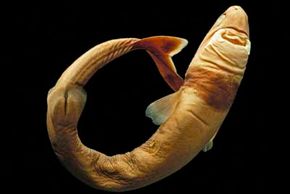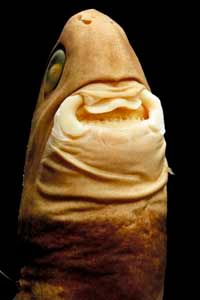Next to a great white shark, its cookiecutter cousin looks like a piece of cake. Better-known shark species like the great whites and tiger sharks dwarf the cookiecutter shark that maxes out around 20 inches (50 centimeters) of length. Judging by its brown, slender profile, a cookiecutter looks almost docile, sometimes referred to as a "cigar fish" because of its brown body.
Advertisement
These small sharks reside in the deep sea, around 11,500 feet (3,500 meters) below the surface [source: ReefQuest Centre for Shark Research]. At night, however, they migrate toward the top of the water where they find their meals. Mostly calling tropical and subtropical waters home, cookiecutter sharks have been spotted in the Pacific and Atlantic Oceans, as well as the Caribbean Sea and Amazon River [source: ReefQuest Centre for Shark Research].

But the diminutive name and size belie this shark's bite. As soon as you see a cookiecutter shark's smile, you immediately understand how it upholds the shark family reputation associated with ferocious hunting. Surrounded by relatively large, flabby lips, the cookiecutter's mouth houses a formidable set of pearly whites. On the top, 30 to 37 teeth stretch across like a set of dentures, and 25 to 31 larger ones extend along the bottom.
Equipped with weak fins and a puny body, cookiecutter sharks wouldn't make successful predators. Instead, they are the only parasitic fish in the shark family that feed off hunks of flesh ripped out of larger fish [source: Parker]. The bites don't kill their hosts, but are enough to satisfy the small sharks' appetites.
Cookiecutter sharks get their name from the almost perfectly round, cookie-shaped wound they leave on their victims. Think of the cookiecutter shark as the Zorro of the sea, slashing its signature marks onto foes that generally include marlin, dolphin, tuna, stingrays, seals and other sharks [source: Florida Museum of Natural History]. Some fish scientists even suspect that cookiecutter sharks have taken bites out of almost every tropical sea dweller [source: ReefQuest Centre for Shark Research].
Advertisement

